()( ROADTEST
Page 32
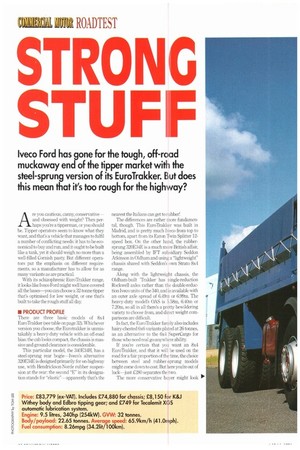
Page 34
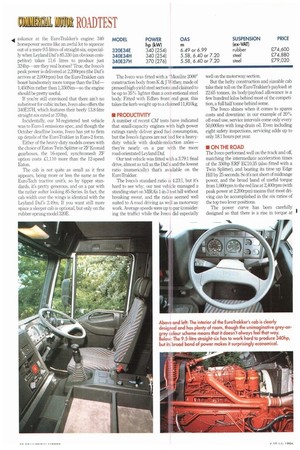
Page 36
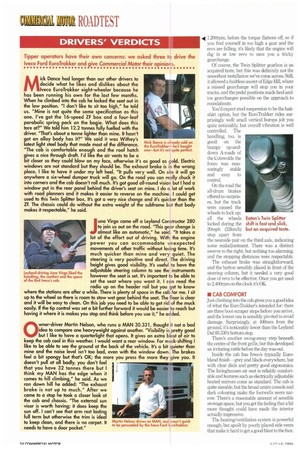
Page 37
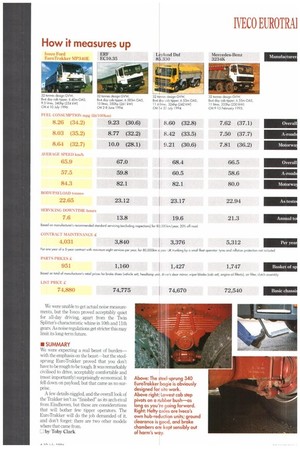
Page 35
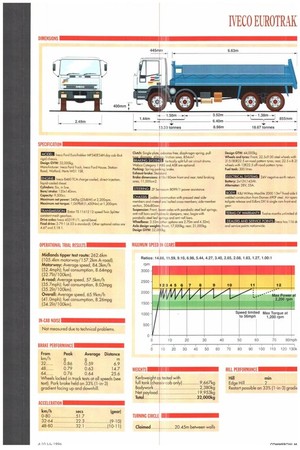
If you've noticed an error in this article please click here to report it so we can fix it.
STRONG
• 4TUFF Iveco Ford has gone for the tough, off-road muckaway end of the tipper market with the steel-sprung version of its EuroTrakker. E ut does this mean that it's too rough for the highway?
Are you cautious, canny conservative and obsessed with weight? Then perhaps you're a tipperman, or you should be. Tipper operators seem to know what they want, and that's a vehicle that manages to fulfil a number of conflicting needs: it has to be economical to buy and run, and it ought to be built like a tank, yet it should weigh no more than a well-filled Cornish pasty. But different operators put the emphasis on different requirements, so a manufacturer has to allow for as many variants as are practical.
With its schizophrenic EuroTrakker range, it looks like Iveco Ford might well have covered all the bases—you can choose a 32-tonne tipper that's optimised for low weight, or one that built to take the rough stuff all day • PRODUCT PROFILE There are three basic models of 8x4 EuroTrakker (see table on page 32). Whichever version you choose, the Eurotrakker is unmistakably a heavy-duty vehicle with an off-road bias: the cab locks compact. the chassis is massive and ground clearance is considerable.
This particular model, the 340E34H, has a steel-sprung rear bogie—Iveco's alternative 320E34E is designed primarily for on-highway use, with Hendrickson-Norde rubber suspension at the rear: the second "E" in its designation stands for 'elastic--apparently that's the nearest the Italians can get to rubber!
The differences are rather more fundamental, though. This EuroTrakker was built M Madrid, and is pretty much Iveco from top to bottom, apart from its Eaton Twin Splitter 12speed box. On the other hand, the rubbersprung 320E34E is a much more British affair, being assembled by JET subsidiary Seddon Atkinson in Oldham and using a "lightweight" chassis shared with Seddon 's own Strato 8x4 range.
Along with the lightweight chassis, the Oldham-built 'Trakker has single-reduction Rockwell axles rather than the double-reduction Iveco units of the 340, and is available with an outer axle spread of 6.49m or 6.99m. The heavy-duty model's OAS is 558m, 6.40m or 7.20m, so all in all there's a pretty bewildering variety to choose from, and direct weight comparisons are difficult,
In fact, the EuroTrakker family also includes hairy-chested 6x6 variants plated at 26 tonnes, as an alternative to the 6x4 SuperCargo for those who need real go-anywhere ability.
If you're certain that you want an 8x4 EuroTrakker, and that it will be used on the road for a fair proportion of the time, the choice between steel and rubber-sprung models might come down to cost. But here you're out of luck—just £280 separates the two.
The more conservative buyer might look askance at the EuroTraldier's engine: 340 horsepower seems like an awful lot to squeeze out of a mere 9.5 litres of straight-six, especial. ly when Leyland Daf's 85.330 (an obvious competitor) takes 11.6 litres to produce just 324hp—are they real horses? True, the Iveco's peak power is delivered at 2,200rpm (the Daf's arrives at 2,000rpm) but the EuroTrakker can boast handsomely more torque than the Daf1,450Nm rather than 1,350Nrn—so the engine should be pretty useful.
If you're still convinced that there ain't no substitoot for cubic inches, Iveco also offers the 340E37H, which features their beefy 13.8-litre straight-six rated at 370hp.
Incidentally, our M-registered test vehicle was to Euro-1 emissions spec, and though the October deadline looms, Iveco has yet to firm up details of the EuroTrakker in Euro-2 form, Either of the heavy-duty models comas with the choice of Eaton Twin Splitter or ZF Ecomid gearboxes, the 16-speed, synchromesh ZF option costs £1,110 more than the 12-speed Eaton.
The cab is not quite as small as it first appears, being more or less the same as the EuroTech tractive unit's, so by tipper standards, it's pretty generous, and on a par with the rather softer looking 85-Series. In fact, the cab width over the wings is identical with the Leyland Daf's 2.49m. If you want still more space a sleeper cab is optional, but only on the rubber-sprung model 320E.
The Iveco was fitted with a "Maxilite 2000" construction body from K & J Withey, made of pressed high-yield steel sections and claimed to be up to 35°,0 lighter than a conventional steel body. Fitted with Edbro front end gear, this takes the kerb weight up to a claimed 11,810kg.
• PRODUCTIVITY A number of recent CM tests have indicated that small-capacity engines with high power ratings rarely deliver good fuel consumption, but the Iveco's figures are not bad for a heavyduty vehicle with double-reduction axles— they're nearly on a par with the more road-orientated Leyland Daf.
Our test vehicle was fitted with a 3.79:1 final drive, almost as tall as the Daf 's and the lowest ratio (numerically) that's available on the EuroTrakker.
The Iveco's standard ratio is 4.23:1, but it's hard to see why; our test vehicle managed a standing start on MIRAs 1-in-3 test hill without breaking sweat, and the ratios seemed well suited to A-road driving as well as motorway work. Average speeds were up to par (considering the traffic) while the Iveco did especially well on the motorway section.
But the hefty construction and sizeable cab take their toll on the EuroTraldier's payload: at 22.65 tonnes, its body/payload allowance is a few hundred kilos behind most of the competition, a full half tonne behind some.
The Iveco shines when it comes to spares costs and downtime: in our example of 20% off-road use, service intervals come only every 50,000km with long-drain oil. Even including eight safety inspections, servicing adds up to only 18.1 hours per year.
• ON THE ROAD The Iveco performed well on the track and off, matching the intermediate acceleration times of the 350hp ERF EC10.35 (also fitted with a Twin Splitter), and beating its time up Edge Hill by 25 seconds. So it's not short of midrange power, and the broad band of useful torque from 1,000rpm to the red line at 2,400rpm (with peak power at 2,200rpm) means that most driving can be accomplished in the six ratios of the top two lever positions.
The power curve has been carefully designed so that there is a rise in torque at 1,200rpm, before the torque flattens off, so if you find yourself in too high a gear and the revs are falling, it's likely that the engine will dig in at low revs to save you a tricky gearchange.
Of course, the Twin Splitter gearbox is an acquired taste, but this was definitely not the smoothest installation we've come across. Still, it allowed a faultless ascent of Edge Hill, where a missed gearchange will stop you in your tracks, and the pedal positions made heel-andtee gearchanges possible on the approach to roundabouts.
You'd expect steel suspension to be the hair' shirt option, but the EuroTrakker rides surprisingly well: small vertical bumps jolt you quite noticeably, but overall vibration is well controlled. The handling, too, is good: on the bumpy up-anddown A-roads of the Cotswolds the lveco was reassuringly stable and easy to control.
On the road the all-drum brakes offered no surprises, but the track tests caused the wheels to lock up: all the wheels Eaton's Twin Splitter locked during the shift is fast and slick, 20mph (32km/h) but an acquired taste. stop apart from
the nearside pair on the third axle, indicating some maladjustment There was a distinct swerve to the right, but nothing too alarming, and the stopping distances were respectable.
The exhaust brake was straightforward, and the button sensibly placed in front of the steering column, but it needed a very good dose of revs to be effective. Once you get used to 2,400rpm on the clock it's OK.
• CAB COMFORT
Just climbing into the cab gives you a good idea of what the EuroTrakker's intended for: there are three boot-scraper steps before you arrive, and the lowest one is sensibly pivoted to avoid damage. Surprisingly, at 400min from the ground, it's noticeably lower than the Leyland Daf 85.330's bottom step.
There's another swing-away step beneath the centre of the front grille, but this developed an irritating rattle before the day was out.
Inside the cab has Iveco's typically Eurobland finish—grey and black everywhere, but with clear dials and pretty good ergonomics. The Isringhausen air seat is reliably comfortable and features such as electrically adjustable heated mirrors come as standard. The cab is quite sizeable, but the broad centre console and dark colouring make the footwells seem narrow. There's a reasonable amount of sensible stowage space, but you get the feeling that a bit more thought could have made the interior actually impressive.
The heating/ventilation system is powerful enough, but spoilt by poorly placed side vents that make it hard to get a good blast to the face.
We were unable to get actual noise measurements, but the Iveco proved acceptably quiet for all-day driving, apart from the Twin Splitter's characteristic whine in 10th and 11th gears. As noise regulations get stricter this may limit its long-term future.
• SUMMARY We were expecting a real beast of burdenwith the emphasis on the beast-but the steelsprung EuroTrakker proved that you don't have to be rough to be tough. h was remarkably civilised to drive, acceptably comfortable and (most importantly) surprisingly economicallt fell down on payload, but that came as no surprise.
A few details niggled, and the overall look of the Trakker isn't as -finished" as its arch-rival from Eindhoven, but these are considerations that will bother few tipper operators. The EuroTrakker will do the job demanded of it, and don't forget: there are two other models where that came from.
0 by Toby Clark Price: £83,779 (ex-VAT). Includes £74,880 for chassis; £8,150 1,4KW Withey body and Edbro tipping gear; and £749 for Tecalemit automatic lubrication system.
Engine: 9.5 litres, 340hp (254kW). GVVV: 32 tonnes.
Body/payload: 22.65 tonnes. Average speed' 65.9km/h (41.0r iph). Fuel consumption: 8.26mpg (34.214/100km).
SPECIFICATION
Iveco Ford EuroTrakker MR340E34H day cab 8x4 rigid chassis, Design DWI: 32,000kg.
Manufacturer. Iveco Ford Truck, Ivaco Ford House, Station Rood, Watford, Herts WD1 1SR, MODEL
MIMI New 8460 TCA charge-cooled, directinjection,
lia,d -cooled diesel
Cylinders: Six, in line.
Bore/stroke; 120x140mm.
Capacity: ,.500cc.
Maximum net power: 340hp1254kW) at 2,200rprn.
Maximum net torque: 1,069Ibh (1,450Nrn) at 1,200rpm
=PM Eaton TS 11612 12-speed Twin Splitter constortmesh gearbox.
Drive axles: tveco 453191/1, spiral bevel
Final drive: 319-1 (4 23 is standard), Other optional ratios are 4.67 and 5 18 1. ME=r F Sel-voccrn 8099/1 power assistance.
EMEll Ladder'consmudion with pressed steel side members and riveted ant Oohed cross-members, side-member section, 304x80mm.
Suspension: Front, eearn axles with parabolic steel leaf springs, anti-roll bars and hrOdrau ic dampers, rear, bogie with parabolic steel leaf Springs and onh roll bars.
Wheelbase: 3 52m lather options are 2.70m and 4,32ml, Axle design weighti: Front, 17,000kg; rear, 21,000kg. Design GVW: 32,000kg Design GPM 44,000kg Wheels and lyres: Front, 22 5x9 00 steel wheels with 315/80822.5 omroad pattern tyres: rear, 22 5* 8.2.! wheels with 12R22 5 off-road-patiern tyres.
Fuel tank: 300 litres.
ELECTRICAL syslEms 24V negative earth return Battery:
OPERATIONAL TRIAL RESULTS
Midlands tipper test route: 262.6km (105.4km motorway/157.2km A-road). Motorway: Average speed, 84.3km/h (52.4mph); Fuel consumption, 8.64mpg (32.71it/100km) A-road: Average speed, 57.5km/h (35.7mph); Fuel consumption, 8.03mpg (35.21it/100km).
Overall: Average speed, 65.9km/h (41.0mph); Fuel consumption, 8.26mpg (34.21it/100km).
IN-CAB NOISE Not measured due to technical problems.
BRAKE PERFORMANCE From Peak Average Distance km/h g g m 32 0.86 0_59 6.9 48 0.79 0.63 14_7 64 0.76 0.64 25.6 Wheels locked in track tests at all speeds (see text). Park brake held on 33% (1-in-3) gradient Facing up and downhill.
ACCELERATION
km/h secs (gear)
0-80 51.7 32-64 22.3 (9-10) 48-80 32.1 (10-11) WEIGHTS
Kerbweight as tested with Full tank (chassis-i:ab only) 9,667kg
Bodywork 2,380kg Net payload 19,953kg Total 32,000kg
TURNING CIRCLE 1/1
Claimed 20.45m between walls
HILL PERFORMANCE
Hill min Edge Hill 2 Restart possible on 33% (1-in-3) gradi(
DRIVERS' VERDICTS
Tipper operators have their own concerns: we asked three to drive the lveco Ford EuroTrakker and dive Commercial Motor their oeinion s.
Mick Dance had longer than our other drivers to decide what he likes and dislikes about the Iveco EuroTrakker eight-wheeler because he has been running his awn for the last few months. When he climbed into the cab he locked the seat out in the low position. "I don't like to sit too high," he told us. "Mine is not quite the same specification as this one. I've got the 16-speed ZF box and a four-leaf parabolic spring pack on the bogie. What does this tare at?" We told him 12.2 tonnes fully fuelled with the driver. "That's a...,k...,ut a tonne lighter than mine. It hasn't got an alloy body has it?" We said it was Withey's latest light steel body that made most of the difference. "The cab is comfortable enough and the roof hatch gives a nice through draft. I'd like the air vents to be a
bit closer so they could blow on my face, otherwise it's as good as gold. Electric windows are not standard but they should be. The exhaust brake is in the wrong place. I like to have it under my left heel. "It pulls very well. On site it will go anywhere a six-wheel dumper truck will go. On the road you can really chuck it into corners and the cab doesn't roll much. It's got good all-round vision but I had a window put in the rear panel behind the driver's seat on mine. I do a lot of work with road planners and it makes it easier to reverse on the machine. I could get used to this Twin Splitter box. It's got a very nice change and it's quicker than the ZE The chassis could do without the extra weight of the subframe but that body makes it respectable," he said.
June Virgo came off a Leyland Constructor 280 to join us out on the rood. "This gear change is almost like an automatic," he said. "It takes a lot of the effort out of driving. With the engine power you can accommodate unexpected movements of other traffic without losing time. It's much quicker than mine and very quiet. The steering is very positive and direct. The driving height gives good visibility. It's useful to have the adjustable steering column to see the instruments however the seat is set. It's important to be able to set the seat where you want it. I can read the radio up on the header rail but you get to know
where the stations are after a while. There is plenty of space in the cab for me. I sit up to the wheel so there is room to stow wet gear behind the seat. The floor is clear and it will be easy to clean. On this job you need to be able to get rid of the muck easily. If the tip control was set a bit further forward it would be easier to reach but having it where it is makes you stop and think before you use it," he added.
Leyland-driving Juno Virgo liked the handling, the comfort and the space of the 8,4 !veto's tab.
Owner-driver Martin Nelson, who runs a MAN 30.331, thought it not a bad idea to compare one heavyweight against another. "Visibility is pretty good but I like to have a quarterlight that opens. It gives an extra bicist of air to keep the cab cool in this weather. I would want a rear window. For mock-shifting I like to be able to see the ground at the back of the vehicle. It's a bit quieter than






















































































































